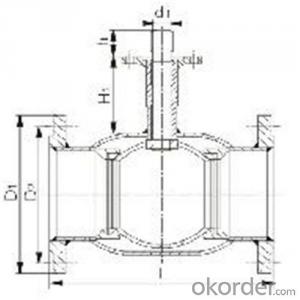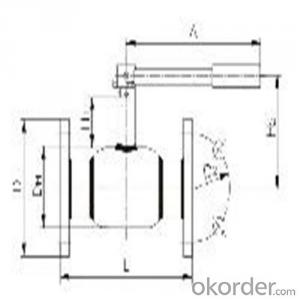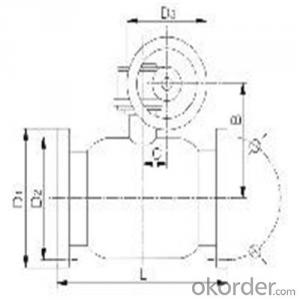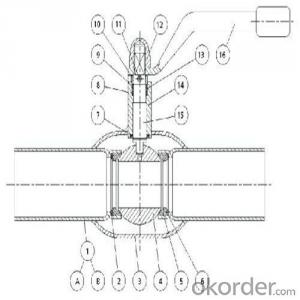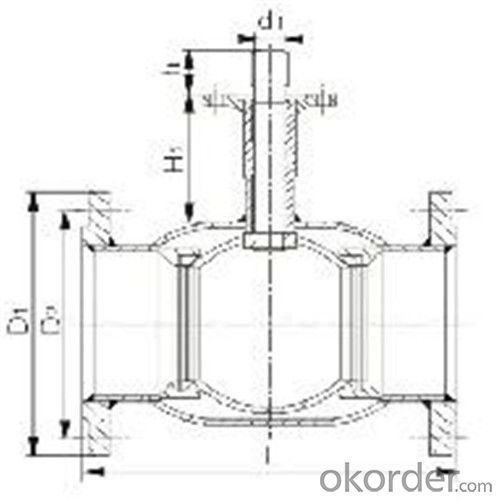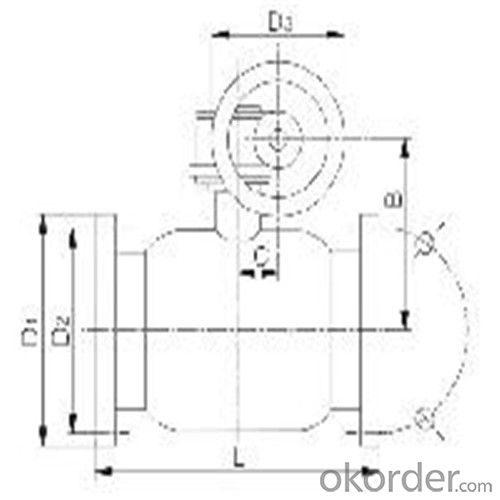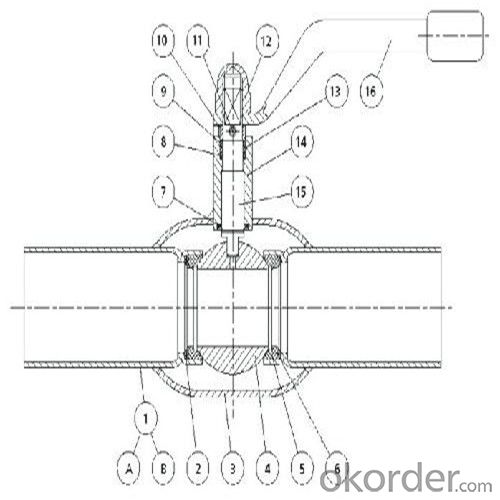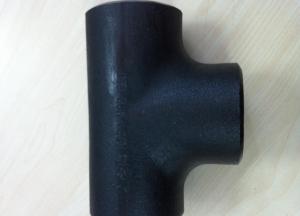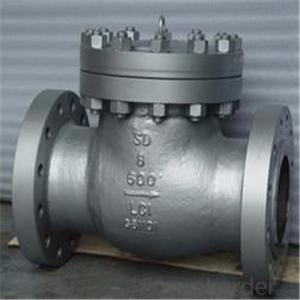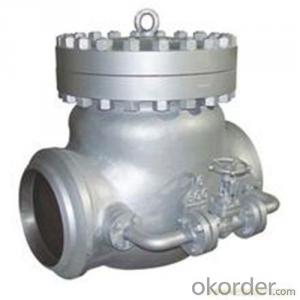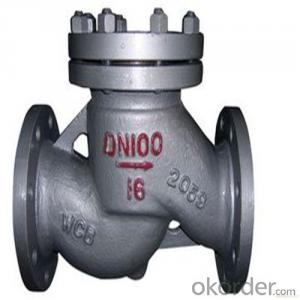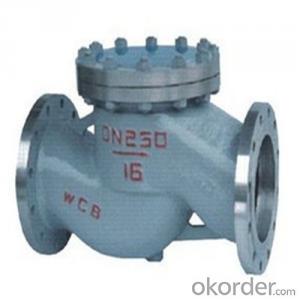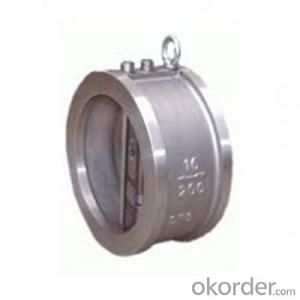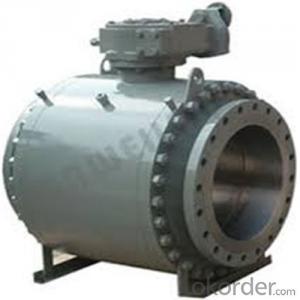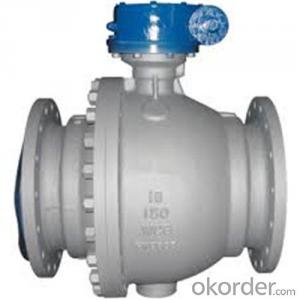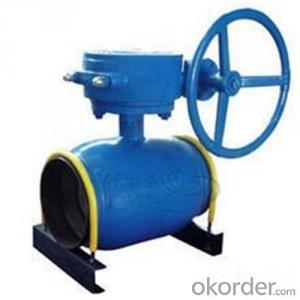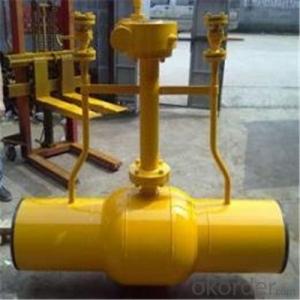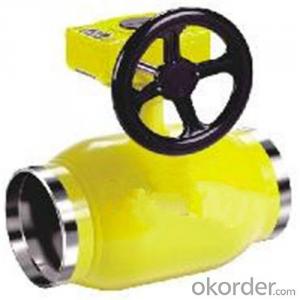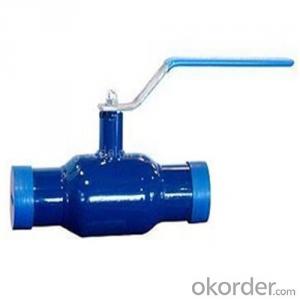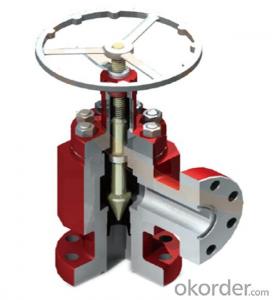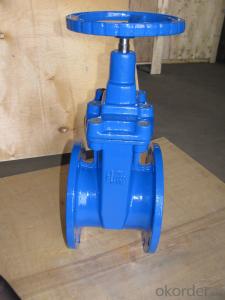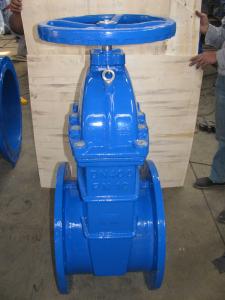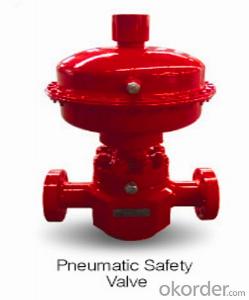Ball Valve For Heating SupplyDN 200 mm high-performance
- Loading Port:
- Shanghai
- Payment Terms:
- TT OR LC
- Min Order Qty:
- 100 pc
- Supply Capability:
- 1000 pc/month
OKorder Service Pledge
OKorder Financial Service
You Might Also Like
Ball Valve For Heating Supply
Product Description of Ball valve for heating supply:
Technical introduction
★The ball valve is designed as fully welded structure,which can prevent the leakage of medium.
★The valve seat is floating and spring-loade.The seal is made of soft seal materials of PTFE+20%C and Viton B.The seat is tightly abutted against the ball surface by the pressure of a spring,so that even if the media is in low pressure,a reliable sealing can be assured for the ball valve.Double piston effect and double seal(two-seal seat)are adopted in specially designed valve seat to realize double sealing,which makes the tightness of the ball valve more advantageous and the operation easier.
★A floating ball is adopted for DN15-DN200,and a stem and trunnion ball is adopted for DN200 and above,which can ensure the accurate position of different size ball.In other words,the sealing performance,low torque valve and operability can be guaranteed.
★The sealing of the stem is fulfilled by two replaceable O-rings and packing consisting of PTEE+20%C or flexible graphite,as the packing seal material,is fire proof effect,and is specially suitable for fuel gas systems.
★The materials used for the valve body and pipelines are the same(carbon steel or SS steel),valve body and stem adopt SS steel and the packing adopts PTEE+20%C which is corrosion-resistance or flexible graphite.
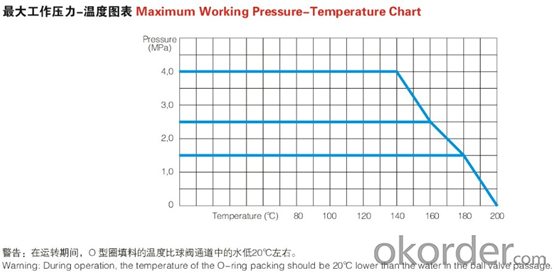
Design Features of Ball valve for heating supply:
Features and Applications
Raymond's fully welded ball valve for heating supplyand Fuel Gas systemare used to control the flow at fully open or closed position,not regulate the flow.Only special types of ball valves can realize the flow regulation.Therefore,our welded ball valves can satisfy the requirements of heating systems,e.g:
★Main pipelines of heating equipment
★Cross channels of heating pipes
★Heat exchanger station and any long distance operating station,e.g:
For the transmission of hot water and two kinds of mixed media(water,air or natural gas),limited to Max.4.0MPa and 200°C.
For the transmission of natural gas and one medium,from -30°C to 60°C,and even up to 150°C using specially designed ball valves.
★Coal gas pipelines,trunk and the branch supply lines.
Standard of Ball valve for heating supply:
Actuator | Gear Handwheel customize |
Connection | Flange SW Weld customize |
Medium | Gas Natural gas Water customize |
Medium Temperature | <200< span="">℃ customize |
Application Fields | Electricity Medical Petrochemical customize |
Connection Standard | EN 1092-1 EN 12627 ISO 7-1 customize |
FAQ of Ball valve for heating supply:
Q1:I can’t find the type of steel check valve which I need. what can I do?
The chart above only lists out some common composition of steel check valve parts.We may provide other different parts material composition according to the customer's request or the actual valve working condition.
Q2:Which certification do your products pass?
Our products are in accordance with ISO 9001、ISO 14001、API 6A、API 6D、TS CE、API607/6FA/BS6755.
Q3:How can I place an order?
The only one thing you should do is to tell us the sepecification about type 、quantity and mode of transportation, then we will send you quotation within 24 hours.
- Q: I accidentally pushed the pressure release valve on my hot water heater last night. It ran for a while, and did not stop. I turned the water off, the valve on the cold water piper above the water heater, and it stopped running. Will this stop running at some point? The overflow tray fills too quickly for me to drain it. When I turn the water back on it starts pouring out again. HELP!!!
- After long periods of inactivity, mineral deposits will form on the pressure side of the valve. When you pushed the valve some of the deposits likely lodged in the valve preventing it from closing all of the way. The good news is that you need not replace your water heater. The bad news is you will likely need a new valve. It is important to replace the valve in these situations because the same mineral deposits that prevent it from closing now can also prevent it from opening when it is needed to relieve excess pressure.
- Q: i wanted to know what is the actual difference between check valve (non return valve) and globe valve?
- A non-return valve is a globe valve with the disk attached so it can slide up and down. Back pressure will shut the valve even if the handwheel is in the open position. There will be a direction of flow arrow cast or stamped into the valve body. A regular globe valve has the disk threaded or pinned to the stem so it can't fall down. The previous answer was referring to a flapper type check valve and you can easily see by the valve body that they are not the same.
- Q: I know nothing about toliets - so please bare with me. The water valve underneath my toliet is dripping and I have to turn off the water in order for it to stop. It's really annoying to have to turn the water on when I want to flush it and have to empty out the container that is catching all the time. I think it has something to do with the valve itself and I'm PRETTY sure something behind it needs to be tightened - Has this happened to anyone else? What did you do?
- Hi. If the valve quits leaking when you turn it off and you are sure it has something to do with the valve then try this. Turn on the water fully until it is just snug and then look just under the handle for what is called a gland nut. The nut is to tighten a packing to prevent leaks. Tighten this nut until it is just 'firm'. Try not to overtighten this nut because you want to have the packing last as long as you can. Try several tightenings of the nut if it still leaks. If it does not stop the leak the valve will have to be replaced. It is a big hassle to replace the packing. I have done it before and it works ok in most experience. It is just a teflon impregnated string that you wrap around the stem after taking off the gland nut. Of course the water has to be turned off for this process. Hope this helps.
- Q: My sump pump shut-off valve is very noisey. I wrapped insulation around it, but it still clunks. The clunk can keep me awake.
- If you mean the discharge check valve, it will clunk when the level switch trips the pump. The head or weight of the water trying to flow back into the crock causes the check valve to slam closed, making a clunking sound. This is pretty common and normal.
- Q: I jsut got my valve cover replaced on my car what does that do?
- it covers up the valves to keep the oil in the engine
- Q: Could my subs kill my EGR valve? I replaced my O2 sensor and my check engine light didn't go off. So I had it checked again and the same problem was still there. It said that all the cylinders were running either rich or lean..... I can't remember. But I was told it could be the EGR Valve so I replaced it and for about a week the check engine light was off.Now its back on. Had it checked again and the same deal was going on. Oh there was also a low voltage reading..... which is why I'm thinking its my subs.So could it be my subs that keeps killing my EGR valve? And any solutions will be helpful. I don't want to have to replace my alternator because its in an extremely tough place to reach. And I already have a small Cap.... .5. My subs handle 600 RMS total. WOuld getting a bigger Cap help?
- Thank you for having such a powerful system! I am investing in hearing aids, and you and hundreds of thousands like you will make me rich in my retirement! The sub-woofers are not affecting your EGR valve. It is operated by a vacuum controlled by the ECM to regulate how much exhaust gas is to be fed back into the engine to control the NOx emissions. You want to make sure that there is no recall on the controller, or that it hasn't' failed. Follow the vacuum hose on the EGR valve to where it goes. That is the controller. Do a google search or look on Expert Village for a video.
- Q: Defects in which valves would produce the following?1) SEVERE DEPENDENT EDEMA?2) PAROXYSMAL NOCTURNAL DYSPEA3) CONGESTED LIVER?4) DISTENDED JUGULAR VEINS?5) PRODUCTIVE COUGH WITH FROTHY SPUTUMfor 1. i believe it's tricupsid valve, 2. mitra valve please correct me if I'm wrong. Thaanks!
- Tricuspid regurgitation: Symptoms of right-sided heart failure, such as ascites, hepatomegaly, edema and jugular venous distension.
- Q: what is the purpose of valves such as: gate valve, foot valve and globe valve in the industry?
- the valves control the flow
- Q: I bought the valve but i have been all over and nobody has a tube that matches mine they all say they have it in stock but once we get there they say it doesnt match. Even online i cant find one that matches. What do i do?
- Can you give a little more info, like what is the year/model, and what is the tube you are speaking of? Are you looking for the heater hose?
- Q: What do I do to make my valves stop ticking? And what makes them tick? its a 94 Acura Integra with a 91 LS motor, 105,000 miles. If I get a new engine head will it stop ticking or the ticking has to do with the block?
- you just neeed to have the valve lash adjusted, 105 is nothing on the B18, my integra had 250k+ before it got totaled and it was still running strong, you dont have to replace the head. and you will have to do more work if your gonna put a GSR on the LS block
Send your message to us
Ball Valve For Heating SupplyDN 200 mm high-performance
- Loading Port:
- Shanghai
- Payment Terms:
- TT OR LC
- Min Order Qty:
- 100 pc
- Supply Capability:
- 1000 pc/month
OKorder Service Pledge
OKorder Financial Service
Similar products
Hot products
Hot Searches
Related keywords

